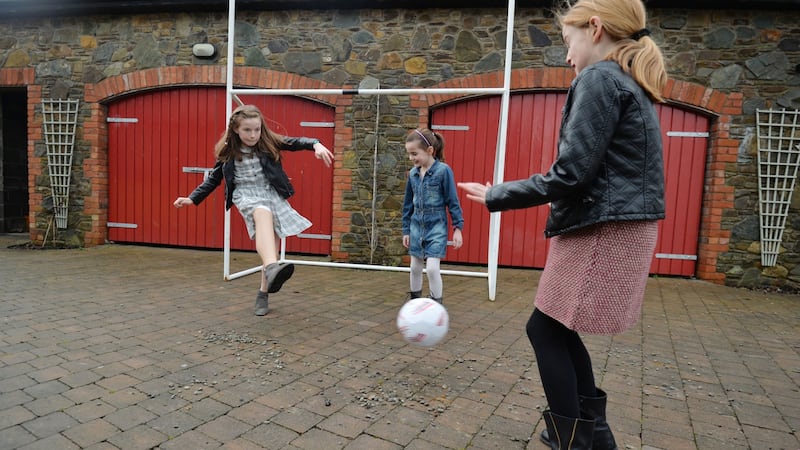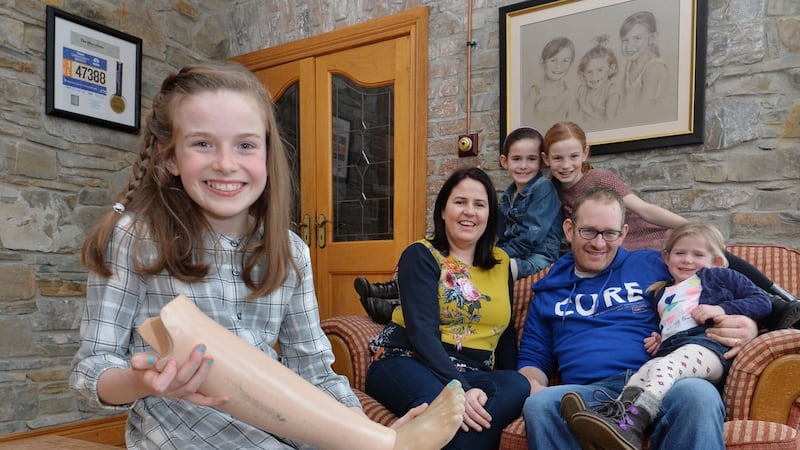‘Even though Amy was blue and the umbilical cord was wrapped around her neck three times, when she was born the first thing I asked was, ‘has the baby all its fingers and toes?’” recalls Amy’s mother Caitríona Sheridan. “And then I saw her leg and it was just twisted in . . . You could see that she had three toes, her big toe and then two other toes stuck together. Straight away you could see there was an abnormality,” she says.
Now 11, Amy was born with fibular hemimelia, a birth defect where part, or all, of the fibular bone is missing. It meant Amy didn’t have a fibula, the long, thin bone in the lower leg that runs parallel to the tibia. Both the tibia and fibula bone come together to form part of the ankle joint. Because Amy’s fibula bone was missing, her ankle, foot and toes hadn’t developed properly on her right leg.
Amy was a very healthy child otherwise, but it was a big shock to new parents Caitríona and her husband Shay from Dunleer, Co Louth. Nothing unusual had showed up in Caitríona's scans during her pregnancy with Amy, who was her first child.


“When we went to Crumlin (Children’s Hospital) we were given three options: leave her alone and she’ll just walk or get on with things as best she could; put her though a lifetime of operations; or amputate the foot and give her a prosthesis and get on with things.
"We still can't remember driving home that day. Amputation – we never thought it could come to that. But we decided that it would be the best thing, because it wasn't like you were operating on a healthy foot. For us it was a big deal because it was our first baby heading in for an operation, but to them of course it was a very minor operation. They're fantastic there. She had her amputation at nine months which went really well and then she got her first prosthesis in Cappagh Hospital the week before her first birthday."
Getting taller
The prosthesis is fitted from the knee down and as Amy gets taller, she gets a new one roughly every 10 months.
As she grew, it became obvious that the knee on Amy’s left leg was ahead of the one on her right, putting her hips and pelvis off balance. The family was told that limb- lengthening operations would have to start.
Amy had the first one when she was four. Her leg was purposely fractured and a metal frame called a Ilizarfov Frame with bolts, and pins that go through the leg, was attached. The pins were turned four times a day, to stretch the bone. She wore the frame for 16 weeks and gained 3.5cm.
“Everything was brilliant after it and she started school. We did a show and tell on her leg to the other kids and it was all normal. She started running club, football and camogie, but when she was nine we noticed her knee was kicking out and rotating around, so we had to go again and try and lengthen the leg and keep the knees as close together (in length) as possible.”
The frame was fitted again, this time for a very tough 26 weeks.
“It’s very tough on the whole system,” says Caitríona. “The pins going in are literally wires and they make holes in your flesh. You’re very susceptible to infections and Amy spent 10 days in hospital with a very high blood infection. She was getting weaker and more tired and sore and she lost loads of weight.
“During the process you’re not eating really well because you’re taking medicine and it puts you off food. Though she wouldn’t have take much medicine. All she could take was Calpol and Tramadol. You can’t take anything stronger, because ibuprofen interferes with the growth of the bone.
“She was in a huge amount of pain. The bone isn’t the sorest part, it’s the muscle and tendons because they have be stretched along with the bone. Amy has a very high pain threshold and she was very brave throughout it.”
Back to sport
After gaining 4cm in length, Amy was looking forward to getting back into sports. But a fall at home in December 2014 ended up breaking her leg.
“It didn’t undo the lengthening, but it certainly didn’t do the leg any good. We had to put back on the frame for another 26 weeks. There is something wonky with it, she can’t straighten her leg now. With her other prosthesis her leg was much straighter. But we’ll be having a check up soon and I hope there will be something that can be done.”
While Amy had to give up team sports, she still goes along to camogie training and takes part in drills. She’s able to go swimming, which she loves, and has recently taken up hip-hop dancing. Despite all the pain, ongoing physio and check-ups, she remains upbeat and rarely feels sorry for herself.
“I’ve never known any different,” says Amy. “If it was someone who was in a farming accident and then they had to go and get one, they’d find it strange. But for me, it’s just my leg.
“ People don’t treat me any differently and you don’t want to be treated different anyway.”








